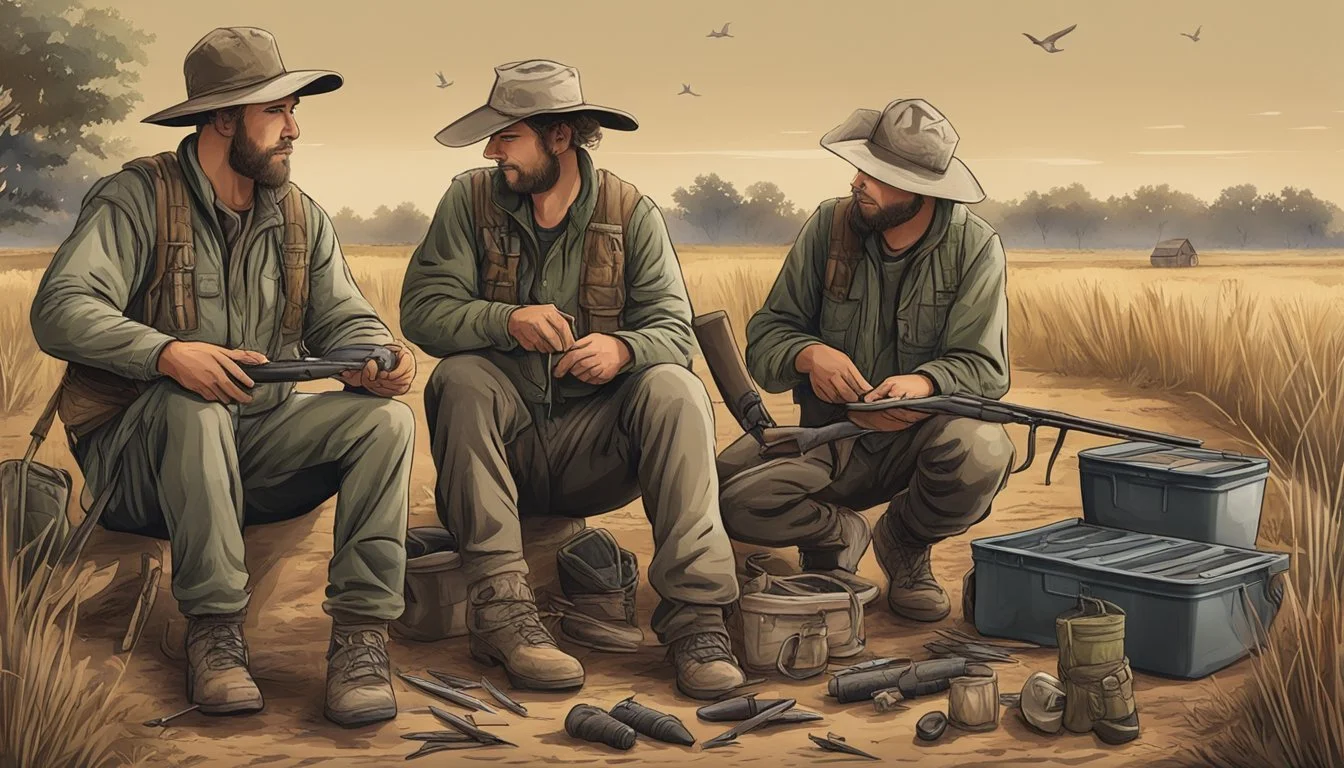Dove Hunting Seasons
Key Dates and Regulations Nationwide
This Article is Part of Our Guide on Hunting Seasons for Over 70 Common Game Species
Dove hunting marks the beginning of the hunting season in many states and provides an opportunity for hunters to engage in a tradition that often serves as a warm-up for other bird-hunting seasons. Known for their swift flight patterns, doves present a challenging target, making this form of hunting popular among seasoned sportspeople and novices alike. In the United States, the mourning dove is the most hunted species and is widely regarded as a game bird.
Regulations for dove hunting vary by state, including specific season dates and limits to ensure sustainable game management. For instance, some states like Texas have established a split season structure allowing hunters to take part in the activity at different times in the fall and winter. These periods ensure that the hunt coincides with the doves’ migratory patterns, thereby optimizing the hunting experience while also managing the dove populations effectively.
Hunters keen on participating in dove hunting seasons must familiarize themselves with relevant local regulations, which may include obtaining proper licenses and permits, understanding the daily bag and possession limits, and complying with hunting hours. Additionally, respecting rules about the use of decoys and baiting, as well as reporting banded birds, are fundamental to ensure that the sport remains ecologically responsible and within the frameworks established by wildlife conservation efforts.
Understanding Dove Hunting
Dove hunting is a highly regulated activity that requires understanding the species, compliance with licensing and legal frameworks, and adherence to ethical and conservation practices.
Dove Species Overview
In the world of game birds, various dove species are recognized for hunting. The most common and widely hunted in North America is the mourning dove. Other species include the white-winged dove, white-tipped dove, Eurasian collared-dove, rock dove (also known as pigeon), band-tailed pigeon, Inca dove, and the common ground dove. Each species has unique characteristics and habitats, influencing their legality and seasons for hunting.
Hunting Licenses and Regulations
To participate in dove hunting, one must acquire the proper hunting license. The requirements vary by state, but generally, hunters need a state-issued license along with a Migratory Bird Treaty Act compliant stamp, such as the Texas Migratory Game Bird Stamp Endorsement for hunting species like dove. In addition to state regulations, hunters must adhere to federal guidelines, which include registering with the Harvest Information Program (HIP). Precise legal shooting hours are established and enforced to support sustainable hunting practices.
Ethics and Conservation
Ethical hunting involves respecting the U.S. Fish and Wildlife Service regulations to ensure the conservation of migratory birds. Aside from doves, these principles apply to waterfowl and other game birds such as snipe, sandhill crane, woodcock, coot, and rail. Regulations help balance hunting activities with the preservation of species, allowing for their continued abundance. Hunters play a crucial role in conservation by following the established laws and contributing to the management and research programs through their licensing fees.
Preparation for Dove Hunting Season
Successful preparation for the dove hunting season involves choosing the correct equipment and refining essential shooting skills. Hunters must equip themselves with appropriate gear and practice to ensure precision and safety in the field.
Selecting the Right Equipment
An essential step is the selection of a shotgun suitable for dove hunting. The ideal shotgun for this purpose is typically a 12, 20, or 28 gauge with a comfortable fit and good balance. When it comes to shotshells, experts recommend No. 7.5 or No. 8 shot due to its effective spread pattern against small, agile doves. It's crucial to use the correct loads; for standard conditions, a moderate-velocity, 1-ounce load of No. 8s is commonly used, while 1 to 1⅛ ounces of No. 7½ shot may be preferred for late-season conditions.
When it comes to ammunition, regulations often stipulate the use of non-toxic shot such as steel, particularly in areas designated for waterfowl conservation where the use of lead is prohibited. Additionally, proper clothing is paramount; hunters should opt for lightweight, breathable attire that allows for mobility and comfort in potentially hot weather.
Equipment Type Description Shotgun 12, 20, or 28 gauge with a good fit and balance Shotshells No. 7.5 or No. 8 shot for a suitable spread pattern Loads 1-ounce load of No. 8s; 1 to 1⅛ ounces No. 7½ Ammunition Non-toxic shot required in many hunting areas Clothing Lightweight, heat and sweat-wicking materials
Honing Hunting Skills
Effective shooting skills are paramount in dove hunting, where the quarry is known for erratic flight patterns. Hunters should engage in significant practice before the season begins. This could involve shooting at clay targets to simulate the movement of doves, focusing on developing a smooth mark and swing to improve chances of a hit. Rehearsing shots at varying angles helps prepare hunters for the real-world conditions they will encounter.
Practicing with skeet shooting can also provide an excellent method for sharpening skills, as it offers a variety of angles and speeds, closely mimicking the challenges of dove hunting. The objective is to familiarize oneself with the shotgun's point of aim and build muscle memory for quick, accurate shots. Regular practice is necessary to ensure that, by opening day, hunters will have the confidence and competence to make ethical and effective shots on doves.
Skill Development Methods and Benefits Practice with Clay Targets Improves marksmanship and anticipation of bird movement Skeet Shooting Offers diverse angles and speeds for realistic preparation Swing and Follow-Through Builds muscle memory for improved shooting consistency
Dove Season Timings and Zones
Dove hunting in Texas is organized into distinct zones and dates, each with its own regulations. This ensures hunters understand the legal hunting periods and any special opportunities available to them.
Understanding Season Dates
North Zone: Dove season commences on September 1 and continues until November 13. Following a break, it resumes from December 17 to January 1.
Central Zone: The season starts on September 1 and runs through October 30. It reopens from December 17 to January 15.
South Zone: Hunters in this zone can hunt from September 14 to October 29, and then again from December 15 to January 21.
Special White-Winged Dove Days: In the South Zone, these days are set aside for September 1-3 and September 8-10.
Legal Shooting Hours: While specific hours may vary, they generally extend from 30 minutes before sunrise to sunset. Always verify the exact legal shooting times for the zone.
Falconry: Statewide falconry season allows hunting from November 17 to December 3.
Special Regulations and Opportunities
Daily Bag Limit: Hunters should know that there is a specified number of doves one can hunt per day. This varies by zone and should be confirmed before planning a hunt.
Possession Limit: The possession limit typically is a multiple of the daily bag limit and includes the number of doves that can be held over a period of days.
Special Regulations: It's legal to hunt doves over areas where agricultural operations have occurred naturally. This includes areas with scattered seeds or grains from regular farming activities.
Hunters must always consult current regulations to verify information as it can be subject to changes by the governing wildlife departments.
Techniques for Successful Dove Hunts
Successful dove hunting hinges on meticulous scouting and refined shooting strategies. Hunters who master these techniques increase their chances of a rewarding hunt.
Scouting and Location Setup
Scouting is pivotal when preparing for dove hunting. Hunters should observe fields and potential hunting grounds days before the season opens to identify patterns of dove movement. Key locations include water sources, fields with ample food sources like sunflower or wheat, and areas where doves roost. The right field will witness doves traveling back and forth, often between their feeding areas and water.
As for location setup, utilizing dove decoys can be extremely effective. Set up these decoys in a visible location, preferably at the edge of a field near a water source to simulate a natural dove environment. Hunters should position themselves with the sun at their backs to avoid detection, as doves have sharp eyesight and can be easily spooked.
Effective Shooting Strategies
Wingshooting requires skill and practice. Hunters must understand their shotgun's effective range, which is typically around 20-30 yards. A common technique is pass-shooting, where hunters shoot doves as they fly by. To increase the chances of a successful shot, one must lead the dove, anticipating its path and firing ahead of its current position.
Decoying doves can also offer more stationary targets as doves come in to land. In these scenarios, hunters must remain still and camouflaged until the bird is within range. Matching the correct shotgun chokes to the typical shot distances can also affect success rates in dove hunting. Whether pass-shooting or decoying, hunters should always focus on safety and ethical hunting practices, ensuring clean shots within their effective range.
Ethical Hunting and Wildlife Management
When it comes to dove hunting, adhering to ethical hunting practices and wildlife management regulations plays a crucial role in the conservation of species and habitats. Hunters and landowners are responsible for ensuring that their actions comply with legal standards and contribute to sustainable hunting.
Baiting and Wildlife Laws
Baiting, the practice of attracting game with food such as grains, is strictly governed under wildlife laws. According to the Migratory Bird Treaty Act, it is illegal to hunt migratory birds, such as doves, over baited areas. An area is considered baited for 10 days after the removal of the bait. Legitimate agricultural practices, however, are exempt from this ruling. Hunters must be aware that the following conditions define legal hunting with respect to baiting:
Areas with normal agricultural activities: Hunters may shoot doves on lands where seeds or grains have been scattered as a direct result of standard agricultural operations, which include harvesting, post-harvest manipulations, or planting.
Non-agricultural baiting: It is unlawful to hunt any migratory game bird over crops that have been artificially placed or manipulated to attract game.
Land Stewardship and Public Lands
Ethical hunting extends beyond following regulations; it embodies responsible land stewardship. Hunters utilizing public lands must respect the rules set forth for these areas:
Private versus public: While private landowners manage their properties, public lands are held to a community standard, where habitats are preserved for wildlife and recreational activities.
Respect for land and wildlife: On public lands, hunters should maintain the environment by removing any trash or spent shells, keeping water sources clean, and disturbing the natural habitat as little as possible.
Throughout the hunting season, it is vital for hunters to be mindful of legal shooting hours, as these are established to ensure a balance between effective wildlife management and ethical hunting practices. Adherence to these principles and regulations by hunters and landowners supports the preservation of dove populations and their habitats for future generations.
Post-Hunt Practices and Considerations
After a successful dove hunting trip, there are vital steps that hunters need to take to ensure proper handling of their harvest and to adhere to conservation efforts. These steps play a crucial role both in maintaining the quality of the game and in supporting the ongoing management of dove populations.
Proper Handling of Harvest
Harvesting:
Once a hunter has successfully taken doves, it is important that the birds are handled properly to preserve the quality of the meat. The birds should be placed in a bucket or game bag to keep them clean and cool.
It is recommended to pluck the doves as soon as possible after the hunt and to remove the innards, which prevents the onset of bacteria and preserves the taste and quality of the meat.
Storage:
To prevent spoilage, hunters should cool down the harvest quickly, using either a refrigerator or a cooler with ice packs.
For the transport of harvested doves, it is important to follow state regulations, which often require that the wings or head remain attached to the bird for identification by conservation officers until the hunter reaches their permanent residence or a processing facility.
Reporting and Conservation Contributions
Harvest Information Program (HIP):
Hunters are typically required to be registered with the HIP, which is a data collection system used by the U.S. Fish and Wildlife Service to estimate the number of all migratory birds harvested throughout the country. This data is critical for the management of these species.
Species-Specific Reporting:
When hunting species like the band-tailed pigeon, which may have additional regulations, hunters must ensure to report their harvest as required. This not only assists in complying with the law but also contributes to conservation efforts.
It is the hunter's responsibility to report their harvest accurately, which may involve keeping a record of the number and species taken during each hunt and reporting these figures as required by local regulations.
Extensions of Dove Hunting
Expanding beyond dove hunting allows hunters to apply their acquired skills to a broader range of migratory species, maximizing opportunities for hunting various birds during the appropriate seasons.
Hunting Other Migratory Species
Dove hunters are well-positioned to transition to hunting other migratory birds due to their existing knowledge of birds' flight patterns and behavior. For instance, hunters can pursue birds like snipe, woodcock, and coot, each having their own unique challenges and bag limits. Realizing the nuances of hunting these species — such as understanding the habitat of snipe or the swift flight of woodcock — can enhance the hunting experience. Rail hunting also provides an extension of opportunities, demanding a careful approach to these elusive birds' dense habitats.
Snipe: Fast flyers requiring precise shooting skills.
Woodcock: Often found in wooded areas, demanding stealth and agility.
Coot & Rail: Typically in wetlands, offering an engaging hunt.
Utilizing Dove Hunting Skills in Other Hunts
Dove hunting hones a set of skills that are transferable to other types of hunting. Wingshooting proficiency developed during dove seasons is particularly beneficial. Hunters must be adept at judging distances, leading targets, and patterning their shotguns to ensure a successful hit. Such skills are essential when hunting larger migratory birds like the sandhill crane, which presents a larger but more distant target.
Wingshooting: A critical skill in hunting migratory birds.
Patterning Shotguns: Understanding how to pattern a shotgun can determine the successful take of birds in flight.
Moreover, hunters must be aware of bag limits and regulations, which vary by species and region. For example, sandhill cranes are subject to strict regulations and often require special permits. Maintaining precise shot placement and understanding migration trends are elements that dove hunt seasoned individuals are typically familiar with, allowing for a smoother adaptation to hunting these larger game birds when in season.






